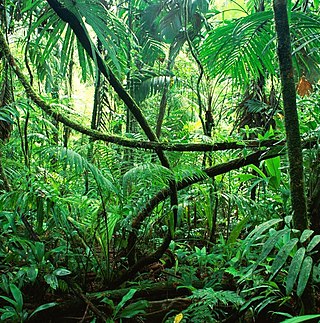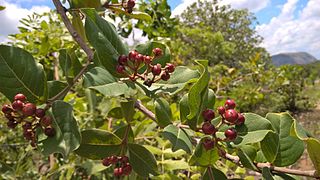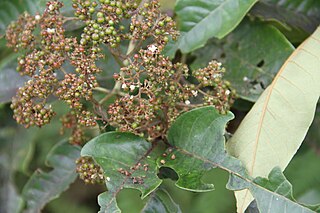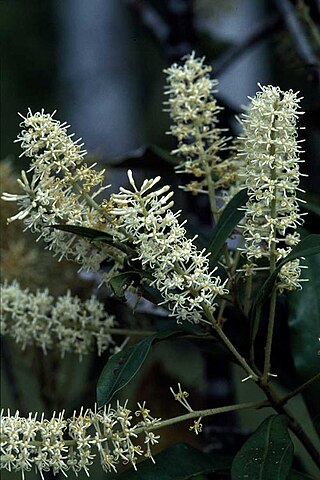
Rainforests are forests characterized by a closed and continuous tree canopy, moisture-dependent vegetation, the presence of epiphytes and lianas and the absence of wildfire. Rainforests can be generally classified as tropical rainforests or temperate rainforests, but other types have been described.

Tropical and subtropical moist broadleaf forests (TSMF), also known as tropical moist forest, is a subtropical and tropical forest habitat type defined by the World Wide Fund for Nature.

Xanthocercis is a tree genus in the family Fabaceae. It includes three species native to sub-Saharan Africa.

Shorea is a genus of about 196 species of mainly rainforest trees in the family Dipterocarpaceae. The timber of trees of the genus is sold under the common names lauan, luan, lawaan, meranti, seraya, balau, bangkirai, and Philippine mahogany.

Cyrilla racemiflora, the sole species in the genus Cyrilla, is a flowering plant in the family Cyrillaceae, native to warm temperate to tropical regions of the Americas, from the southeastern United States, south through the Caribbean, Mexico and Central America to northern Brazil and Venezuela in South America. Common names include swamp cyrilla, swamp titi, palo colorado, red titi, black titi, white titi, leatherwood, ironwood, he-huckleberry, and myrtle.

Annona montana, the mountain soursop, is a tree and its edible fruit in the Annonaceae family native to Central America, the Amazon, and islands in the Caribbean. It has fibrous fruits. A. montana may be used as a rootstock for cultivated Annonas.

Agathis dammara, commonly known as the Amboina pine or dammar pine, is a coniferous timber tree native to Sulawesi, the Maluku Islands and the Philippines.

Heritiera littoralis, commonly known as the looking-glass mangrove or tulip mangrove, is a mangrove tree in the family Malvaceae native to coastal areas of eastern Africa, Asia, Melanesia and northern Australia. The common name refers to the silvery appearance of the underside of the leaves, resembling a mirror to some degree. The strong timber has uses in marine applications and elsewhere.
The target rat is a species of rodent in the family Muridae. It is the only species in the genus Stochomys. Its natural habitat is subtropical or tropical moist lowland forests.

The tit hylia is a species of bird, monotypic within the genus Pholidornis. It is found in rainforests in West and Central Africa. It had been placed in the family Cettiidae, but in 2019 its assignment to a new family, the Hyliidae, was strongly supported.
Michelsonia is a genus of tree in the legume family, Fabaceae, where it is classified in the subfamily Detarioideae. It is a monotypic genus, the only species being Michelsonia microphylla. It is native to the tropical rain forests of the Democratic Republic of the Congo. The wood is used locally for construction work.

Psorospermum febrifugum is a species of flowering plant in the family Hypericaceae. It is found across tropical Africa in seasonally dry tropical biomes. French botanist Édouard Spach described Psorospermum febrifugum in 1836.

Harungana madagascariensis is a flowering plant found in Madagascar that is commonly known as the dragon's blood tree, orange-milk tree or haronga.

Neorites is a monotypic genus of plants in the family Proteaceae. The sole species Neorites kevedianus, commonly called fishtail oak or fishtail silky oak, is a tall tree endemic to the wet tropics rainforests of north eastern Queensland, Australia.

Carnarvonia araliifolia, commonly known as the red oak, red silky oak, Caledonian oak or elephant's foot, is the sole species in the genus Carnarvonia, a member of the Proteaceae family. It is endemic to the rainforests of northeastern Queensland, Australia.

Nothorites is a monotypic genus in the macadamia family Proteaceae. The sole species, Nothorites megacarpus, is endemic to the wet tropics rain forests of northeastern Queensland, Australia.

Goniocheton arborescens, commonly known in Australia as Mossman mahogany, is a small tree in the mahogany family Meliaceae. It is native to rainforests of Malesia, Papuasia, Queensland and nearby islands.

Strombosia pustulata is a species of tree in the family Olacaceae. It is native to the rainforests of tropical West and Central Africa. Common names for this tree include itako in Nigeria, afina in Ghana, poé in Abé spoken in Côte d'Ivoire and mba esogo in Equatorial Guinea.

Gilbertiodendron dewevrei is a species of tree in the family Fabaceae, native to tropical rain forests in Central Africa. It is often the dominant tree species of the Guineo-Congolian rainforest. The timber is traded as limbali, and is used for construction, flooring and railway sleepers. It is also used for making boats, furniture, tool handles and joinery and for making charcoal.

Carpolobia alba is a plant species in the milkwort family (Polygalaceae) that is endemic to rainforests, forest fringes, and savanna-park with altitudes below 400 metres (1,300 ft) in Western Tropical Africa. It is a shrub or small tree which is 3 to 6 metres tall. Its branches are puberulous or shortly pubescent. Its leaves are membranous or slightly leathery. The flowers it produces are yellowish white or white with a crimson spot at the base of upper petals. It produces yellow or scarlet-coloured fruit which are edible and usually contain 3 seeds. It was first described by George Don in 1831. It is used traditionally as a medicine against sexual dysfunction.


















